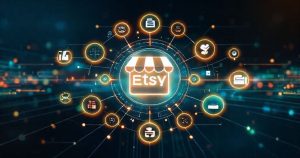For independent creators and small business owners, Etsy provides a vibrant marketplace to showcase unique handmade and vintage items. As these businesses grow, the demands of managing inventory, processing orders, handling shipping, and keeping financial records can become overwhelming. Strategic Etsy integrations offer a powerful solution, connecting your shop with external software and services designed to automate tasks, centralize data, and significantly enhance operational efficiency. By leveraging these tools, sellers can reclaim valuable time, reduce manual errors, and focus more on creativity and business development, ultimately transforming their Etsy venture into a more scalable and manageable enterprise.
Understanding the Landscape of Etsy Integrations
Etsy integrations refer to the process of linking your Etsy shop’s data and functionalities with third-party applications and platforms. This connectivity allows for seamless data flow, enabling automation across various aspects of your business operations. The primary goal is to eliminate repetitive manual tasks, ensuring consistency and accuracy across different systems. Whether it is synchronizing product listings, automating order fulfillment, or streamlining financial reporting, integrations act as a digital bridge, empowering sellers to manage their business more efficiently and effectively. Understanding this fundamental concept is the first step toward optimizing your Etsy presence.
Key Integration Categories for Etsy Sellers
Optimizing an Etsy business often involves integrating various tools to manage different operational facets. These integrations typically fall into several key categories, each addressing specific pain points and offering distinct advantages. Understanding these categories helps sellers identify which solutions will provide the most significant impact on their daily operations and long-term growth. From managing stock levels to ensuring accurate financial records, a comprehensive approach to integration can transform a small craft hobby into a robust and scalable online business endeavor.
1. Inventory Management Integrations
Managing inventory across multiple sales channels or even a large Etsy catalog can be complex. Inventory management integrations automatically sync stock levels between your Etsy shop and other platforms or dedicated inventory software. This prevents overselling, reduces the need for manual stock updates, and ensures accurate product availability for customers. For example, if an item sells on your personal website, the integration automatically adjusts the quantity on Etsy, saving time and potential customer disappointment. Such integrations are crucial for maintaining business integrity and customer satisfaction.
2. Shipping and Fulfillment Integrations
Efficient shipping is critical for customer satisfaction on Etsy. Shipping integrations connect your Etsy orders directly with shipping carriers or fulfillment services. These tools automate label printing, generate tracking numbers, and often update order statuses within Etsy automatically. Many platforms also offer rate comparisons across different carriers, helping sellers find the most cost-effective shipping options. Streamlining this process significantly reduces the time spent on order fulfillment, allowing sellers to dispatch products faster and provide timely tracking information to eager buyers, enhancing the overall purchasing experience.
3. Accounting and Bookkeeping Integrations
Keeping accurate financial records is paramount for any business, including an Etsy shop. Accounting integrations automatically import your Etsy sales data, fees, and expenses into popular accounting software. This automation significantly reduces manual data entry, minimizes errors, and simplifies tax preparation. Sellers gain a clear overview of their profitability, manage cash flow more effectively, and ensure compliance with financial regulations. Integrating with tools like QuickBooks or Xero can transform a time-consuming chore into a streamlined process, providing valuable insights into the financial health of your Etsy business.
4. Marketing and CRM Integrations
Building customer relationships and promoting products are essential for growth. Marketing and CRM (Customer Relationship Management) integrations connect your Etsy customer data with email marketing platforms, social media tools, or dedicated CRM systems. These integrations allow for targeted email campaigns, automated follow-up messages, and personalized marketing efforts. By understanding customer purchase history and preferences, sellers can create more effective promotions, encourage repeat purchases, and foster stronger brand loyalty. This strategic approach to customer engagement can significantly boost sales and expand your customer base.
Strategic Advantages of Integrating Your Etsy Shop
The decision to integrate various tools with an Etsy shop extends beyond mere convenience; it offers significant strategic advantages that can propel a business forward. These benefits range from operational enhancements to improved customer interactions, all contributing to a more robust and resilient online presence. Understanding these overarching benefits helps sellers appreciate the true value proposition of investing time and resources into a well-planned integration strategy. Ultimately, integrations empower sellers to scale their operations with greater confidence and efficiency.
Enhanced Efficiency and Time Savings
One of the most immediate benefits of Etsy integrations is the substantial boost in efficiency and the subsequent time savings for sellers. By automating repetitive tasks such as order processing, inventory updates, and financial data entry, sellers are freed from tedious manual work. This allows them to allocate more time to creative endeavors, product development, or marketing initiatives that directly contribute to growth. The ability to manage a growing volume of orders without a proportional increase in workload is crucial for scaling an Etsy business sustainably.
Data Centralization and Accuracy
Integrations consolidate critical business data from various sources into a single, accessible platform. This centralization ensures that all information, from inventory levels to customer details and sales figures, is consistent and accurate across your entire operation. Reduced manual data entry means fewer errors, leading to more reliable reporting and better decision-making. Having a unified view of your business performance allows for a clearer understanding of trends, profitability, and areas requiring attention, facilitating informed strategic planning for your Etsy shop.
Multi-Channel Selling Capabilities
For sellers looking to expand beyond Etsy, integrations are indispensable for managing multi-channel operations. By connecting Etsy with platforms like Shopify or WooCommerce, businesses can synchronize inventory and orders across multiple storefronts seamlessly. This capability prevents overselling and simplifies order fulfillment, allowing sellers to reach a broader audience without the added complexity of managing separate data sets. Such integrations facilitate growth into new markets while maintaining efficient and centralized control over all sales activities.
Improved Customer Experience
Integrations directly contribute to a superior customer experience by streamlining post-purchase processes. Automated shipping label generation, real-time tracking updates, and personalized communication through CRM tools ensure that customers receive prompt and accurate information about their orders. Faster processing and reliable updates build trust and satisfaction, encouraging repeat business and positive reviews. A seamless customer journey, from purchase to delivery, significantly enhances brand reputation and fosters long-term customer loyalty within the competitive Etsy marketplace.
Factors to Consider When Choosing Etsy Integrations
Selecting the right Etsy integrations is a crucial decision that can significantly impact your business’s trajectory. It involves careful consideration of several factors to ensure that the chosen tools align with your specific needs and goals. Rushing this process can lead to incompatible systems or unnecessary expenses, hindering rather than helping your operations. A thoughtful evaluation process ensures that every integration serves a clear purpose, contributing positively to your business’s efficiency, growth, and overall success in the competitive online marketplace.
Business Needs and Scale
The most important factor is understanding your current business needs and future growth aspirations. A small hobby shop might only require basic accounting integration, whereas a growing enterprise with multiple channels will need comprehensive inventory and shipping solutions. Evaluate your pain points: Are you spending too much time on manual inventory updates, or is shipping a bottleneck? Choosing integrations that directly address these challenges and can scale with your business ensures that your investment continues to provide value as your Etsy shop evolves.
Integration Costs and ROI
Integrations come with various pricing models, including monthly subscriptions, per-transaction fees, or one-time purchases. It is essential to evaluate the total cost of ownership and, more importantly, the potential return on investment (ROI). Consider the time saved, reduction in errors, and potential increase in sales or efficiency that the integration offers. While specific pricing varies widely based on features and provider, understanding how a tool will save you money or generate more revenue is crucial for making a financially sound decision for your Etsy business.
Ease of Use and Support
The best integration is one that is easy to set up, understand, and use on a daily basis. A complex system with a steep learning curve can negate the benefits of automation. Look for intuitive interfaces and clear documentation. Furthermore, reliable customer support is invaluable. In case of issues or questions, readily available and responsive support can prevent significant downtime and frustration. Testing free trials or demos can help assess the user-friendliness and the quality of support offered before committing to a long-term solution.
Security and Data Privacy
Integrating third-party tools means sharing your business and customer data. Therefore, prioritizing security and data privacy is paramount. Ensure that any integration you choose adheres to strict data protection standards and complies with relevant privacy regulations. Research the provider’s reputation, read their privacy policy, and understand how they handle sensitive information. Protecting your customers’ data and your business’s intellectual property is not just good practice, but a critical component of maintaining trust and avoiding potential legal issues.
Navigating Common Etsy Integration Challenges
While Etsy integrations offer numerous benefits, sellers might encounter certain challenges during implementation and ongoing use. Recognizing these potential hurdles beforehand allows for proactive planning and smoother problem-solving. Understanding common issues ensures that sellers can approach integrations with a realistic perspective, mitigating risks and maximizing the positive impact on their business. Addressing these challenges effectively is key to fully harnessing the power of integrated systems for your Etsy shop.
Compatibility Issues
One common challenge is ensuring that chosen integration tools are fully compatible with Etsy’s API and with each other if you’re using multiple systems. Incompatibility can lead to data not syncing correctly, features not working as expected, or even system crashes. Thorough research and, if possible, testing free trials are essential before committing to any integration. Always check for official Etsy partnerships or strong user reviews regarding specific integrations to confirm their reliability and seamless operation within the Etsy ecosystem.
Data Synchronization Conflicts
Even with compatible tools, data synchronization conflicts can arise. This might occur if changes are made manually in Etsy while an integration attempts to push different data, leading to discrepancies, duplicates, or overwriting of information. Establishing a clear workflow and understanding which system acts as the “source of truth” for specific data points (e.g., inventory levels, order status) is crucial. Regular monitoring of data flow and immediate resolution of any conflicts are necessary to maintain data integrity across all platforms.
Over-Reliance on Automation
While automation is a significant benefit, an over-reliance on it can sometimes detract from the personal touch that many buyers appreciate on Etsy. Fully automating customer communication, for instance, might make interactions feel generic. It is important to find a balance where automation handles repetitive tasks, but strategic moments, like personalized thank-you notes or addressing unique customer inquiries, still receive human attention. Maintaining your brand’s unique voice and connection with customers is vital, even with the most advanced integrations.
Conclusion
Strategic Etsy integrations offer a transformative pathway for sellers to scale their businesses, enhance efficiency, and deliver an exceptional customer experience. By carefully selecting and implementing tools for inventory management, shipping, accounting, and marketing, sellers can automate tedious tasks, centralize data, and gain invaluable insights into their operations. While challenges like compatibility and data synchronization exist, proactive planning and a clear understanding of your business needs will ensure a smooth integration process. Ultimately, embracing these powerful digital connections empowers Etsy entrepreneurs to navigate the complexities of online commerce with greater confidence and secure long-term success.






